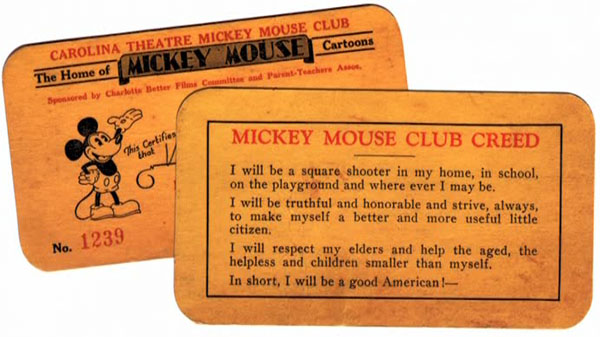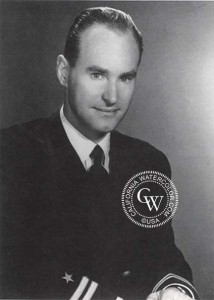
Mickey Mouse Club 1931. Theaters often needed safety even back in 1931 when the Fox Mission Theater in Southern California had its Saturday morning Mickey Mouse Club which would cost a dime for two hours of entertainment. Here is the Friday newspaper advertisement:
9:45: Doors open
10:10: Mickey Mouse song reels
10:15: Mickey Mouse cartoon Karnival Kid
10:23: The Mickey Mouse feature film, Amos’n’Andy in Check and Double Check, promises to be a riot of comedy. Don’t miss seeing these two clever comedians if you enjoy laughing.
11:41 Aunt Polly of the Junior Mercury Herald club will introduce a grand big pie-eating contest, and if you have never witnessed one of these exciting events, you certainly have missed a lot of fun. There will also be prizes for the lucky boy and girl.
11:51: Are you wondering what is going to happen in the next chapter of the “Vanishing Legion” serial? So are we all, and the only way to find out is to attend tomorrow’s matinee.
12:10: Children, don’t forget to receive your free candy after the show.
Note to Parents: Remember that safety for the Mickey Mouse matinee audience at the Fox Mission theater is assured at all times during the children’s show. From 10 o’clock until 12:15, there are two officers and a fire inspector in the theater audience; thus you may feel free to send your children to the theater without escort if you wish.
Nightmare Audience. Jeffrey Katzenberg, chairman of the Walt Disney Studios told Adweek magazine in October 1993 that “We know (The Nightmare Before Christmas) is not for three, four and five year olds. There are some images that are too scary for really young ones.” He went on say that the studio’s research indicated three distinct potential audiences: the pre-teen set, people drawn to Tim Burton’s reputation and adults attracted by the film’s artistic and experimental nature.
 Katzenberg had wanted Burton to cut Oogie Boogie’s song because of the torturing of Santa Claus. “Yeah, they really wanted that part cut way down,” Burton told Entertainment Weekly magazine October 29, 1993.
Katzenberg had wanted Burton to cut Oogie Boogie’s song because of the torturing of Santa Claus. “Yeah, they really wanted that part cut way down,” Burton told Entertainment Weekly magazine October 29, 1993.
Disney was helpless because final cut and creative autonomy were Burton’s conditions for working with Disney. “It’s amazing how misleading storyboards can be. All the Oogie Boogie stuff, I really didn’t have a clue until we saw the finished footage,” said David Hoberman, president of both the Disney and Touchstone labels. The film was released under the Touchstone label.
Doug Gone. In 1993, with fifty-two episodes in the can, Nickelodeon’s popular animated series Doug became the first Nicktoon to stop production of new episodes.
 “Sixty-five was always batted around as the magic number,” said Jim Jinkins, head of Jumbo Pictures which produced the Emmy and CableACE nominated cartoon. “It was a big shock when we heard about it. Everyone called to sort of pay their respects. People like (Nick president) Gerry Laybourne and (Nick head of programming) Herb Scannell because they wanted to make sure there was no bad blood.”
“Sixty-five was always batted around as the magic number,” said Jim Jinkins, head of Jumbo Pictures which produced the Emmy and CableACE nominated cartoon. “It was a big shock when we heard about it. Everyone called to sort of pay their respects. People like (Nick president) Gerry Laybourne and (Nick head of programming) Herb Scannell because they wanted to make sure there was no bad blood.”
A spokesperson for Nickelodeon said, “We stopped at fifty-two episodes because we had enough for our purposes and for international purposes” in terms of rerunning the series. At the time Jumbo productions had twelve projects in development for companies such as Universal and Disney.
Mickey Mouse Coat of Arms. “On the walls inside the (Hyperion) studio, in private offices as well as in conference rooms, are framed drawings of Mickey Mouse in every conceivable pose. Painted on one door in red and gold is a shield bearing Mickey’s Coat of Arms. The mystic words ‘Ickmay Ousmay” are inscribed on this heraldic emblem and they have puzzled studio visitors a good deal. But guests who recall a jargon almost universal among American children grin and translate the gibberish into ‘Mickey Mouse’. This was the language whereby dark secrets were kept from inquisitive adults.” McCalls magazine August 1932.
Olympic Gold Medal Winning Disney Artist. According to the Encyclopedia of the Olympic Games (1972), gold, silver and bronze medals were awarded for art at the quadrennial Olympics from 1912 to 1948. The gold medal for watercolors was only awarded twice: in 1928 to Jean Jacoby of Luxembourg and in 1932 to former Disney artist Lee Blair in 1932 for a rodeo image done in what was known as California Watercolor Style.
The painting was a depiction of a crowded corral, full of horses and lariat-carrying cowboys. It. was donated (some reports say “sold”) to Blair’s alma mater, Polytechnic High School in downtown Los Angeles, where it hung in the library but when the school relocated to Sun Valley in 1957, the painting was lost and the school has no record of it.The first year the Olympics were staged in Los Angeles was 1932. The silver medal in watercolor in 1932 went to Percy Crosby, the creator of the comic strip Skippy. During the 1930s, Blair served two terms as the president of the California Watercolor Society. In 1983, Blair was honored with a lifetime membership in the society “in recognition of unusual achievement in the advancement of water color painting in America”.
Unfortunately that honor only lasted a decade since Blair passed away at the age of 81 in 1993.
“I don’t remember Uncle Lee ever once mentioning it,” said his niece, Jeanne Chamberlain of the gold medal. In fact, she had never seen the medal until 2008. In the wake of the death of Blair’s son, Kevin, Chamberlain was going through family documents stored in a safe deposit box in Northern California. She pushed aside some papers and found a thin, cardboard box.
“I opened it up, and there was the gold medal,” said Chamberlain who then was 74 years old. It looked nearly pristine, as if it had been seldom out of the box.
“Of course,” she said, “I began to cry.”
Blair was sensitive about appearing too old so rarely mentioned the medal because it was closely tied to a specific date.
Probably the only remaining public reminder of Blair’s Olympic achievement is a bronze plaque on the wall of the Los Angeles Memorial Coliseum where his name is listed as a gold medal winner along with those who won in gymnastics, wrestling and sculpture. By the way, Lee had a German shepherd named Frodo.
Picture below of Rodeo.




 Jim Korkis is an internationally respected animation historian who in recent years has devoted his attention to the many worlds of Disney. He was a columnist for a variety of animation magazines. With his former writing partner, John Cawley, he authored several animation related books including The Encyclopedia of Cartoon Superstars, How to Create Animation, Cartoon Confidential and Get Animated’s Animation Art Buyer’s Guide. He taught animation classes at the Disney Institute in Florida as well as instructing classes on acting and animation history for Disney Feature Animation: Florida.
Jim Korkis is an internationally respected animation historian who in recent years has devoted his attention to the many worlds of Disney. He was a columnist for a variety of animation magazines. With his former writing partner, John Cawley, he authored several animation related books including The Encyclopedia of Cartoon Superstars, How to Create Animation, Cartoon Confidential and Get Animated’s Animation Art Buyer’s Guide. He taught animation classes at the Disney Institute in Florida as well as instructing classes on acting and animation history for Disney Feature Animation: Florida.




















































What’s unusual is that Doug was the first Nicktoon that “defected” from
Nickelodeon going to Disney and having several new episodes animated for Disney’s One Saturday Morning for ABC TV (titled Brand Spankin’ New Doug) well as a feature film Doug’s 1st Movie . Jim Jinkins also animated PB&J Otter and the Claymation series Jojo’s Circus for Playhouse Disney (now Disney Junior).
That particular fetish about fire safety in the lead item … perhaps such could be put down to the tragedy at the Glen Cinema in Paisley, Scotland on December 31, 1929, when 69 children attending a penny matinee were trampled to death in a panic-driven rush for the exits after smoke was seen coming from the projectionist’s booth, prompting cries of “Fire!” from the audience. Making matters worse: Managers had deliberately locked the fire exits (as opened inward) to discourage people sneaking in without paying admission.
In any case, the fallout led to fire-safety changes for cinemas the world over, in particular requiring that the fire exits be unlocked at all times and open outwards. Not to mention being prominently identified.
My parents told me that when they were young in Canada (the 1930s), children were generally not allowed in theaters AT ALL, which very few exceptions (such as for Disney films), and that the Scotland theater fire was exactly the reason given.
Ah, the days of the Saturday matinee; that is something that I wish would find a resurgence, bringing classic cartoons back to theaters where they originally premiered, only these are beyond festivals, although some shows can be dedicated to avid collectors and folks who liked the “adult” content that you could find in those old cartoons. Such a resurgence, if it were to happen beyond our wildest dreams, would spark new interest in the classic toons that you don’t see and probably will *NEVER* see on television anymore! Just a thought.
The reason the classic cartoons that the Baby Boomers and others grew up with are being kept from modern viewers is the One World mentality. Here at Conspiracy Corner (between Hooterville, Metropolis and Mayberry) we found that there’s an effort to meld the United States, Canada and Mexico into one country with a common currency. Part of the effort to do that is cultural and Looney Tunes, Popeye, Woody Woodpecker et al are just too “American” for their own good. Note the rise of Dora the Explorer, anime and other “nationality-neutral” cartoons that have pushed the Hollywood classics further out of the mainstream broadcasts. Well, gotta get back to my lair and keep up on all things sinister.
Such an interconnect between Saturday-afternoon matinees and “potboiler” serials was perhaps no doubt lost on Hanna-Barbera when they incorporated Danger Island unto The Banana Splits anthology … and a decade or so later, included Mystery Island as part of Skatebirds.
Likewise with Filmation’s incorporating Jason of Star Command as part of Tarzan and the Super 7.